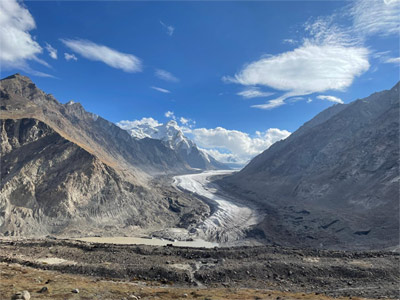
Weather in Zanskar Valley
The weather in Zanskar Valley can be quite extreme and varies depending on the season. Being a remote region in the Indian Himalayas, it experiences a high-altitude climate with significant temperature fluctuations, and its weather can impact your trek. Here’s an overview of the weather you can expect throughout the year:
Summer (June to September):
Temperature: During the summer months, temperatures are relatively moderate, especially during the day. Expect daytime temperatures ranging from 15°C to 25°C (59°F to 77°F), but it can get colder at night, dropping to around 0°C to 5°C (32°F to 41°F).Weather Conditions: Summer is the most popular time to trek in Zanskar, as the weather is the most stable and accessible during these months. The region experiences clear skies, dry conditions, and relatively warmer temperatures, making it ideal for trekking.
Rain: Rainfall is sporadic, but you might experience occasional showers, especially in July and August. However, these are usually short-lived and do not affect the trek much.
Snow: The lower altitudes of Zanskar (around Padum and Phugtal) will have little to no snow in the summer, although higher elevations (like mountain passes) might still have patches of snow.
Autumn (October to November):
Temperature: Temperatures start to dip in the autumn months. Daytime temperatures can be around 10°C to 15°C (50°F to 59°F), but it can drop drastically at night, with temperatures reaching -5°C to -10°C (23°F to 14°F).Weather Conditions: Autumn in Zanskar sees more unpredictable weather, with clear skies but colder winds, especially as the region starts transitioning toward winter. It is still a feasible time for trekking, but prepare for chilly mornings and evenings.
Rain/Snow: Rainfall decreases, but the possibility of early snow in higher regions increases. Some trekking routes might begin to get snowed in, making access to certain areas harder.
Winter (December to February):
Temperature: Winters in Zanskar are extremely cold. Daytime temperatures are often below -10°C (14°F), and at night, it can plummet to -20°C to -30°C (-4°F to -22°F) or even colder, especially in higher-altitude areas.Weather Conditions: This is the harshest time in the valley, with heavy snowfalls, freezing temperatures, and complete isolation. Most roads and trekking trails are closed during winter due to snow, and only local inhabitants in some of the villages remain. It’s not a recommended time for trekking due to the extreme cold and potential risks.
Snow: Snow can cover the valley and its trekking routes, making access impossible without specialized equipment. Some high-altitude areas may experience snow for up to 6-7 months.
Spring (March to May):
Temperature: Spring in Zanskar is still cold, with daytime temperatures ranging from 5°C to 15°C (41°F to 59°F), and nights can still drop below -5°C (23°F), particularly in early spring.Weather Conditions: Spring sees a gradual warming, and the snow from the winter months begins to melt. This can create muddy conditions in lower-altitude regions, but the higher reaches are still cold and may have snow.
Rain/Snow: Snow may persist in the mountains, but rainfall starts to increase in late spring. In early spring, the region is still quite dry, making it a challenging but possible time for trekking.
General Tips for Trekking in Zanskar Valley:
Layering is Key: Due to significant temperature changes, especially between day and night, layering your clothing is crucial. You can easily remove layers during the day when it's warmer, but ensure you have sufficient insulation for cold nights.Sun Exposure: The region is at a high altitude, meaning the UV rays are much stronger. Even on cloudy days, make sure you have sun protection (sunscreen, sunglasses, and hats) to protect your skin and eyes.
Wind Chill: Even in summer, Zanskar Valley can experience cold winds, particularly at higher altitudes. Be prepared for gusty winds, especially in the evening.
Pack for All Conditions: If trekking in the summer, bring both light clothing for daytime warmth and warm layers for the chilly mornings/evenings. A good-quality jacket, gloves, and hat will also be helpful.
Best Time to Trek:
The best time for trekking to Phugtal Monastery and across Zanskar Valley is June to September. The weather is mild, the skies are clear, and the trails are accessible. July and August have the most reliable weather, but if you prefer fewer trekkers, early June or late September can also be a great time to visit.By keeping these important notes in mind, you’ll be well-prepared for your trek to Phugtal Monastery. Would you like additional advice on any specific part of the trek.


